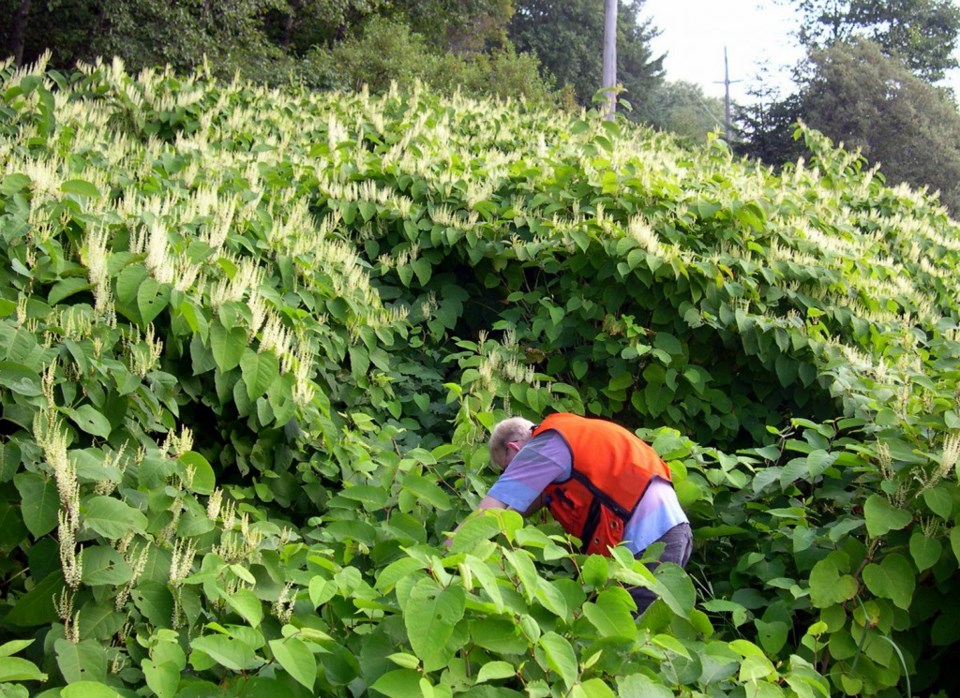Did you know non-native invasive plants can cause ecological, human and economic health impacts?
Also known as noxious weeds, these plants are aggressive, highly destructive and usually difficult to control. Some may be toxic to humans and/or livestock.
They not only out-compete and displace native plant species, thus diminishing wildlife habitat, but can overtake farmland and shorelines, reducing crop yields and grazing value, and affecting such industries as forestry, fishing, tourism, horticulture and recreation. Noxious weeds can also reduce visibility on roadways, cause erosion and create fire hazards.
In the case of Japanese knotweed (Fallopia japonica), this invasive can grow through asphalt and even concrete, threatening residential and municipal infrastructure. Knotweeds spread rapidly through root systems that may extend up to 20 m wide and 3 m deep. Growing rapidly up to 3 m high, knotweeds can spread by fragments of stems and leaves, and are one of the most difficult noxious weeds to eradicate. In fact, knotweeds are now regarded as one of the 100 worst invasive species in the world.
As with many noxious weeds, they are often introduced as a cultivated horticultural specimen. Many retailers continue to sell invasives such as English ivy (Helix hedera) and yellow archangel (Lamnium galeobdolon) as easy-to-grow ground cover in shady areas. Buyer beware!
Another contributing factor is when people unknowingly protect or promote a species for cultural or horticultural reasons. Himalayan blackberry (Rubus armeniacus) is enjoyed for its sweet berries while yellow-flag iris (Iris pseudacorus) and purple loosestrife (Lythrum salicaria) are regarded as “pretty” garden and pond additions.
In the 1970s, Scotch broom (Cytisus scoparius) was planted widely by the California State Department of Transportation as a fast-growing shrub that would prevent erosion. This non-native invasive not only takes over native habitat but is a potent allergen. It also contributes to wildfire fuel loads as its enormous seed banks thrive in dry/drought conditions. Human activities such as vehicle traffic and soil disturbance have contributed to its widespread distribution.
Once an area is cleared of invasive species, you can replace with a variety of attractive, wildlife-beneficial, climate-adapting Pacific Northwest plant species.
Depending on your site’s conditions (sun, shade, moist, dry), refer to the ISCBC’s Be Plant Wise program with its Grow Me Instead guide that illustrates 26 of horticulture’s most unwanted invasive species, along with alternative plants featured for each. Metro Vancouver’s Grow Green website also offers a palette of species and design suggestions.
Melissa Chaun of Port Moody is an ecologist with a passion for all things sustainable. She is events co-ordinator with the Rivershed Society of BC and volunteers on various city committees. Her column runs monthly.
•••••••
What can you do to help?
Since it takes a co-ordinated effort to prevent new weeds from establishing in our region and to control or eradicate weeds already here, it’s imperative that we all stay up-to-date on what plants have been listed as noxious weeds and how best to treat them. Some tips:
• Know what you grow and remember: People move weeds. Before gardening, landscaping, clearing a site, building, driving or boating, check the area for potentially invasive plants.
• Become familiar with the noxious weed list(s). The Invasive Species Council of BC (ISCBC) monitors both the provincially and regionally regulated noxious weeds, as well as the unregulated invasive plants of concern in B.C.
• Practise responsible treatment and disposal methods. The Invasive Species Council of Metro Vancouver produces best management practices for priority noxious weeds, providing the latest proven techniques.
• Be Plant Wise. Do not purchase, trade or grow listed (or suspect) species. Talk with your landscaper, local garden centre or nursery if you suspect they are promoting potentially invasive plant species.
• Do not let weeds go to seed.
• Never dump garden waste or hanging baskets into natural areas.
• Ensure all materials (topsoil, gravel, mulch, compost) are weed-free before purchasing and using.



